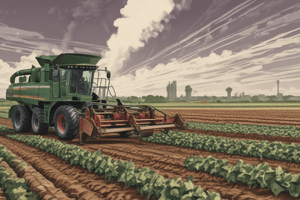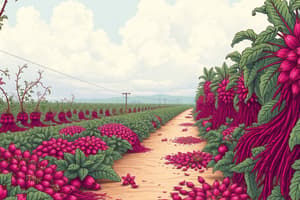Podcast
Questions and Answers
The harvesting of sugar beet typically begins in mid-January and ends in September.
The harvesting of sugar beet typically begins in mid-January and ends in September.
False (B)
During the 'campaign', sugar beet harvesting is conducted continuously without interruption.
During the 'campaign', sugar beet harvesting is conducted continuously without interruption.
True (A)
Lorries transporting sugar beet are weighed and sampled only at the end of the campaign.
Lorries transporting sugar beet are weighed and sampled only at the end of the campaign.
False (B)
The tare consists of non-sugar materials such as clay and stones that are deducted from the gross weight of the beet.
The tare consists of non-sugar materials such as clay and stones that are deducted from the gross weight of the beet.
Two unloading methods for sugar beet are dry unloading and cold unloading.
Two unloading methods for sugar beet are dry unloading and cold unloading.
The sugar content of the beet is measured as 'pol', indicating the amount of sucrose.
The sugar content of the beet is measured as 'pol', indicating the amount of sucrose.
The leaves of sugar beet plants are useful and have less agricultural value than turnips.
The leaves of sugar beet plants are useful and have less agricultural value than turnips.
Wet unloading involves storing the beet in open air silos after it is washed from the lorry.
Wet unloading involves storing the beet in open air silos after it is washed from the lorry.
The clear sugar juice is run off from the bottom of each clarifier.
The clear sugar juice is run off from the bottom of each clarifier.
Lime is added to the juice to precipitate impurities and neutralize acids.
Lime is added to the juice to precipitate impurities and neutralize acids.
Bagasse, the fibrous material left after sugar extraction, is recycled as fuel for the mill boiler furnaces.
Bagasse, the fibrous material left after sugar extraction, is recycled as fuel for the mill boiler furnaces.
Sugar juice extracted from crushing mills is perfectly clear and contains no impurities.
Sugar juice extracted from crushing mills is perfectly clear and contains no impurities.
Cylindrical rotating vacuum filters are used to recover sugar from muddy juice.
Cylindrical rotating vacuum filters are used to recover sugar from muddy juice.
The concentrated juice, known as syrup, contains between 70-75 percent sugar.
The concentrated juice, known as syrup, contains between 70-75 percent sugar.
Crystals of sugar are grown in a process called crystallisation by adding more syrup.
Crystals of sugar are grown in a process called crystallisation by adding more syrup.
Molasses is the syrup that is entirely removed after the first centrifuging process.
Molasses is the syrup that is entirely removed after the first centrifuging process.
The raw sugar is dried by tumbling through a stream of ice cold air.
The raw sugar is dried by tumbling through a stream of ice cold air.
Filter mud mix extracted during processing is beneficial as a soil treatment on cane farms.
Filter mud mix extracted during processing is beneficial as a soil treatment on cane farms.
Stones and grass are removed from beet by using water.
Stones and grass are removed from beet by using water.
Sugar is extracted from beet by means of hot water at 70 °C in a process called extraction.
Sugar is extracted from beet by means of hot water at 70 °C in a process called extraction.
The exhausted beet slices, or pulp, contain high sucrose content after the extraction process.
The exhausted beet slices, or pulp, contain high sucrose content after the extraction process.
The liquid exiting the diffuser is called raw juice and ranges in color from black to a dark red.
The liquid exiting the diffuser is called raw juice and ranges in color from black to a dark red.
Extraction towers are designed to remove sugar from the cossettes using a warm air flow.
Extraction towers are designed to remove sugar from the cossettes using a warm air flow.
The processed pulp from beet contains about 95% moisture when it exits the diffuser.
The processed pulp from beet contains about 95% moisture when it exits the diffuser.
During diffusion, some sucrose can break down into simple sugars and acids.
During diffusion, some sucrose can break down into simple sugars and acids.
Calcium carbonate is added to the juice to precipitate out non-sugars.
Calcium carbonate is added to the juice to precipitate out non-sugars.
The main purpose of carbonatation is to reduce the moisture content of the processed pulp.
The main purpose of carbonatation is to reduce the moisture content of the processed pulp.
After juice purification, the juice turns from dark brown to a light yellow color.
After juice purification, the juice turns from dark brown to a light yellow color.
The liquid pressed out of the pulp is introduced back into the diffuser to enhance sugar extraction.
The liquid pressed out of the pulp is introduced back into the diffuser to enhance sugar extraction.
The extraction of sugar from beet is a counter-current process where cossettes and water flow in the same direction.
The extraction of sugar from beet is a counter-current process where cossettes and water flow in the same direction.
Hot milk of lime is used during carbonatation to precipitate various impurities from the juice.
Hot milk of lime is used during carbonatation to precipitate various impurities from the juice.
Juice purification involves the addition of calcium sulfate to remove non-sugars.
Juice purification involves the addition of calcium sulfate to remove non-sugars.
The final byproduct of sugar processing is called vinasse and is primarily used as a fuel.
The final byproduct of sugar processing is called vinasse and is primarily used as a fuel.
The solution entering the evaporators contains approximately 50% sugar.
The solution entering the evaporators contains approximately 50% sugar.
Mother liquor is the syrup produced during the crystallization process.
Mother liquor is the syrup produced during the crystallization process.
Centrifugals are used to evaporate water from the syrup.
Centrifugals are used to evaporate water from the syrup.
The final syrup from which no more sugar can be economically extracted is known as molasses.
The final syrup from which no more sugar can be economically extracted is known as molasses.
After the juice is extracted from the cane, it still contains a significant amount of impurities.
After the juice is extracted from the cane, it still contains a significant amount of impurities.
Crystallizers are used to concentrate the syrup to form sugar crystals.
Crystallizers are used to concentrate the syrup to form sugar crystals.
The sugar produced from the second batch is known as 'white sugar'.
The sugar produced from the second batch is known as 'white sugar'.
Evaporation in vacuum pans occurs at high pressure to manage the boiling of the syrup.
Evaporation in vacuum pans occurs at high pressure to manage the boiling of the syrup.
The total time from beet washing to white sugar is approximately twelve hours.
The total time from beet washing to white sugar is approximately twelve hours.
The process of crystallization produces only high-quality sugar crystals.
The process of crystallization produces only high-quality sugar crystals.
The remaining syrup after centrifugation is not reused in sugar production.
The remaining syrup after centrifugation is not reused in sugar production.
Bagasse, the fibrous material from the cane, is often recycled as fuel.
Bagasse, the fibrous material from the cane, is often recycled as fuel.
Multiple-effect evaporation is utilized to produce a thick juice containing approximately 70% sucrose by weight.
Multiple-effect evaporation is utilized to produce a thick juice containing approximately 70% sucrose by weight.
Sugarcane is typically harvested in winter months and processed immediately.
Sugarcane is typically harvested in winter months and processed immediately.
Flashcards
Sugar Beet Campaign
Sugar Beet Campaign
The period when sugar beet is harvested and processed into sugar. It typically runs from late September to mid-January, operating 24/7.
Sugar Beet Harvesting
Sugar Beet Harvesting
The process of removing sugar beet from the ground, cleaning it, and removing the leafy tops. Done using specialized machinery.
Weighbridge
Weighbridge
A system used to weigh trucks carrying sugar beet, automatically recording their weight as they pass over it.
Tare
Tare
Signup and view all the flashcards
Sugar Content (Pol)
Sugar Content (Pol)
Signup and view all the flashcards
Sugar Beet Unloading Methods
Sugar Beet Unloading Methods
Signup and view all the flashcards
Reception Area
Reception Area
Signup and view all the flashcards
Sugar Beet Movement
Sugar Beet Movement
Signup and view all the flashcards
Vacuum Pan Process
Vacuum Pan Process
Signup and view all the flashcards
Massecuite
Massecuite
Signup and view all the flashcards
Centrifugal Separation
Centrifugal Separation
Signup and view all the flashcards
Molasses
Molasses
Signup and view all the flashcards
Sugar Crystallization
Sugar Crystallization
Signup and view all the flashcards
Seed Crystal
Seed Crystal
Signup and view all the flashcards
Mother Liquor
Mother Liquor
Signup and view all the flashcards
Evaporation
Evaporation
Signup and view all the flashcards
Evaporator
Evaporator
Signup and view all the flashcards
Cane Crushing
Cane Crushing
Signup and view all the flashcards
Bagasse
Bagasse
Signup and view all the flashcards
Shredder
Shredder
Signup and view all the flashcards
Raw Sugarcane Juice
Raw Sugarcane Juice
Signup and view all the flashcards
Mill
Mill
Signup and view all the flashcards
Cane Transportation
Cane Transportation
Signup and view all the flashcards
Clarification
Clarification
Signup and view all the flashcards
Clarifiers
Clarifiers
Signup and view all the flashcards
Syrup
Syrup
Signup and view all the flashcards
Centrifugals
Centrifugals
Signup and view all the flashcards
Crystallization
Crystallization
Signup and view all the flashcards
Filter Mud
Filter Mud
Signup and view all the flashcards
Diffusion
Diffusion
Signup and view all the flashcards
Cossettes
Cossettes
Signup and view all the flashcards
Raw Juice
Raw Juice
Signup and view all the flashcards
Counter-Flow Principle
Counter-Flow Principle
Signup and view all the flashcards
Juice Purification
Juice Purification
Signup and view all the flashcards
Pulp
Pulp
Signup and view all the flashcards
Carbonatation
Carbonatation
Signup and view all the flashcards
Milk of Lime
Milk of Lime
Signup and view all the flashcards
Vinasse
Vinasse
Signup and view all the flashcards
Thin Juice
Thin Juice
Signup and view all the flashcards
Soda Ash
Soda Ash
Signup and view all the flashcards
Sulphitation
Sulphitation
Signup and view all the flashcards
Invert Sugars
Invert Sugars
Signup and view all the flashcards
Carbonatation Process
Carbonatation Process
Signup and view all the flashcards
Study Notes
Sugar Beet Production
- Harvesting: Campaign starts late September to mid-January, continuous 24/7 processing. Mechanical harvesting removes beets, cleans them, and trims tops (valuable animal feed). Beets transported by lorry to processing plants.
- Weighing and Sampling: Lorries weighed on weighbridge; sample taken to determine sugar percentage & tare (impurities). Tare deducted to calculate net weight; farmers paid based on clean beet weight and sugar content.
- Reception: Beets are weighed and sampled; unloaded into heaps; checked for soil/crown tare and sugar/nitrogen content to determine payment. Moved to central channel/gulley, then washed.
Beet Unloading and Processing
- Unloading: Two systems: dry unloading (beets to silos) or wet unloading (water jets). Beets are transferred from silos to plant, stones/grass removed. Thorough washing before processing to remove impurities.
- Diffusion: Beets sliced into "cossettes"; extracted using hot water at controlled temperatures in diffusers with a counter-current flow system. Sugar solution (raw juice) emerges; contains about 14% sugar, is dark/black. Extruded cossettes/pulp are mixed with molasses and dried for animal feed. Some sucrose breaks down which is a loss in output.
- Further Extraction: Additional sucrose extraction from pulp through screw presses that reduces moisture content. Pressed pulp dried/sold; liquid from pressing is added to raw juice.
Purification and Concentration
-
Purification (Saturation): Removing non-sugars from raw juice. Lime and CO2 are used to precipitate non-sugars; filtered out; juice light yellow.
-
Carbonatation: Removing impurities from raw juice before crystallization. Lime suspension used; CO2 precipitates calcium carbonate which filters impurities; thin juice produced (lighter brown). Modifications to pH using soda ash are possible.
-
Evaporation: Concentrating thin juice (14% sugar) in evaporators to thick juice (60% sugar); stored for later processing.
Crystallization and Finishing
- Crystallization: Thick juice goes into crystallizers; sugar crystals grow as sugar from mother liquor forms around them. Forms a massecuite (sugar syrup mixture). Centrifuging separates sugar crystals from syrup; syrup from centrifuges is recycled.
- Vacuum Pans: Evaporating more water to turn sugar into a crystalline form - done at reduced temperatures and pressure, Pan full, discharged to holding vessels.
- Centrifugals: Separating moist sugar crystals from syrup, which is recycled, until additional extraction is uneconomical, result in molasses. Dried and stored in silos.
Sugar Cane Production
- Transport: Primarily by rail in Australia (95% of cane); some areas use road, depending on proximity to the plant.
- Processing: Cane is weighed; shredded into small pieces to rupture juice cells; pressed through series of rollers/mills.
- Juice Separation: Separates sugar juice; remaining fibrous material is bagasse which is used as fuel.
- Purification: Juice treated with lime, lime neutralizes acids, precipitates impurities. Impurities "settle out" in clarifiers.
- Concentration: Juice concentrated in evaporators (effets); syrup/concentrated juice
- Crystallisation: Syrup concentrated in vacuum pans, seeded with sugar crystals (massecuite), Sugar extraction until not economical. Molasses final product.
- Finished Sugar: Raw sugar dried, stored, then transferred to bulk bins.
Studying That Suits You
Use AI to generate personalized quizzes and flashcards to suit your learning preferences.
Description
This quiz explores the detailed processes involved in sugar beet production, including harvesting, weighing, and unloading methods. It also covers the subsequent processing stages that ensure clean and pure sugar extraction. Test your knowledge on the journey of sugar beets from field to factory.




